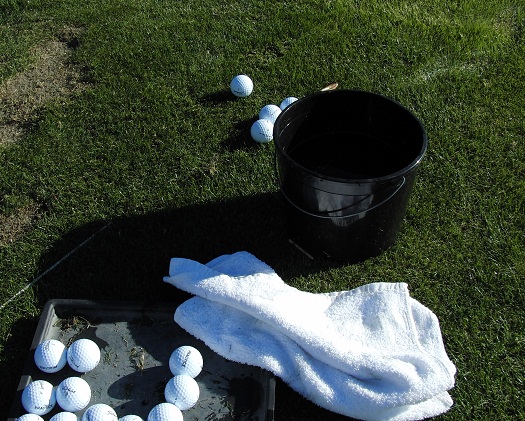Wedges and Water
/ I recently stumbled onto an interesting tidbit whilst working with a young professional on his wedge game. It was early in the morning and we had been hitting beautiful 50 yard pitches the afternoon before and suddenly he could not get the ball to launch low enough with the spin rate he had been generating the day before. Now as you may know I've tested almost all there is to test in regards to a 50 yard wedge shot and of course I had looked into the effect of water interfering with the friction between the face and the ball. One problem - I had tested a wet club striking a dry ball. My results from the earlier test showed very little difference in launch and spin when there was water involved and I had since adopted that belief.
I recently stumbled onto an interesting tidbit whilst working with a young professional on his wedge game. It was early in the morning and we had been hitting beautiful 50 yard pitches the afternoon before and suddenly he could not get the ball to launch low enough with the spin rate he had been generating the day before. Now as you may know I've tested almost all there is to test in regards to a 50 yard wedge shot and of course I had looked into the effect of water interfering with the friction between the face and the ball. One problem - I had tested a wet club striking a dry ball. My results from the earlier test showed very little difference in launch and spin when there was water involved and I had since adopted that belief.
As I watched the young pro struggle to lower his launch in the morning dew it came to me - there was a difference between a wet club striking a dry ball and a dry club striking a wet ball! I had to run the test again.
I had to be very careful with the test in that I needed to use the same club, my 54 degree sand wedge, in very controlled conditions, with golf balls that were consistent. I used brand new Titleist NXT Tour golf balls and made sure that I cleaned the grooves and clubface off between each shot. I attempted to hit each shot to carry 50 yards flat and hit eight shots for each portion of the test. I removed the two shots that had the lowest spin from each portion. With the help of my TrackMan here are the results:
Wet club and dry ball:
- Launch angle was 27.8 degrees
- Spin rate was 5463 rpm
- Height was 26.5 feet
Dry club and wet ball:
- Launch angle was 30.1 degrees
- Spin rate was 5291 rpm
- Height was 28.4 feet
Dry club and dry ball:
- Launch angle was 25.4 degrees
- Spin rate was 6603 rpm
- Height was 21.2 feet
The interesting thing in looking at the trajectory chart is how much lower the dry club and dry ball (purple) shots flew. Clearly there was more friction between the face and ball which led to a lower launch with substantially more spin. The dry club and wet ball (yellow) sample flew the highest as the water on the ball greatly decreased friction which led to higher launch, due to slippage and thus decreased spin - certainly not the optimal shot.
The interesting thing when comparing the wet club/dry ball versus the dry club/wet ball results was that the spin and launch were better when the BALL was dry. This was due to the water being forced off the clubhead and into the groove channels during the motion of the swing. Not to mention that the air dried the face during the swing too.
Moral of the story - always clean the clubface (unless it has sand on it) and dry the club and ball when possible. If you happen to have an early morning tee time and you're a dew sweeper, don't plan on hitting any low spinners! The drier the ball and club, the better the friction and the better the quality of shots you will hit.
Please read my first two articles on wedges and pitching:









